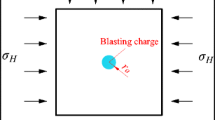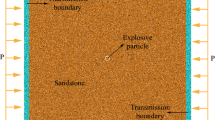Abstract
In the present study, the two-dimensional blast model has been simulated using finite element software Abaqus/CAE. The John–Wilkins–Lee equation of state has been used to calculate the pressure caused by the release of the chemical energy of the explosive. Detonation point from center of hole has been defined for the traveling path of explosive energy. Elastoplastic dynamic failure constitutive with kinematic hardening model was adopted for rock mass responses under high explosive pressure to understand the mechanism of blast phenomena. In this model, it is assumed that failure of rock occurs under tensile failure when yield plastic stress exceeded to its static tensile strength. The hydrostatic pressure was used as a failure measure to model dynamic spall or a pressure cut off. Variation of detonation velocity has been measured in terms of simulation blast output energies index results.








Similar content being viewed by others
References
Abaqus/CAE (2011) Abaqus user’s manual. Dassault Simulia
Ash R (1963) The mechanics of rock breakage. Pit and Quarry. Vol 56. Part 8-11
Bhandari S (1997) Engineering rock blasting operations. Handbook. Pub. A.A.Balkema
Braithwaite W, Brown WB, Minchinton A (1996). The use of ideal detonation computer codes in blast modelling. In: Mohanty, B. (ed.), Proc. 5th Int. Sym. Rock fragmentation by blasting (FRAGBLAST 5), Montreal, Quebec, Canada. Rotterdam, Balkema, pp. 37–44
Duvall WI, Atchison TC (1957). Rock breakage by explosive. U.S. Bur. Mines. Rept. Invest. No. 535
Fourney WL (1993). Mechanics of rock fragmentation by blasting. In Hudson JA (ed) Comprehensive rock engineering—principles, practices and projects. Pergamon. Vol. 1. pp. 39-70
Frantzos DC (1989) Finite element analysis of radial cracking mechanism around blast holes using measured pressure-time curves for low density ammonium nitrate/fuel oil. (Unpublished) PhD thesis. Department of Mining Engineering, Queen’s University, Canada. 290 p
He H, Liu Z, Nakamura K, Abe T, Wakabayashi K, Okada K, Nakayama Y, Yoshida M, Fujiwara S (2002) Determination of JWL equation of state parameters by hydrodynamically analytical method and cylinder expansion test. Jl Jpn Explos Soc 63(4):197–203
Itoh S, Hamashima H, Murata K, Kato Y (2002). Determination of JWL parameters from underwater explosion tests. In: 12th Int. Detonation Symp. San Diego, California. pp. 1-6
Jung WJ, Utagava M, Ogata Y, Seto M, Katsuyama K, Miyake A, Ogava T (2001) Effects of rock pressure on crack generation during tunnel blasting. Jl Jpn Explos Soc 62(3):138–146
Liu L, Katsabanis PD (1998) A numerical description of the formation of a crater in rock blasting. CIM Bull 91(1023):75–81
Monjezi M, Bahrami A, Varjani AY, Sayadi AR (2011) Prediction and controlling of flyrock in blasting operation using artificial neural network. Arab J Geosci 4(3-4):421–425
Monjezi M, Khoshalan HA, Varjani AY (2012) Prediction of flyrock and backbreak in open pit blasting operation: a neuro-genetic approach. Arab J Geosci 5(3):441–448
Nie SL, Olsson M (2000). Study of mechanism by measuring pressure history in blast holes and crack lengths in rock. In Proc. 27th annual conf. Explosives and Blasting Technique. Orlando, US. pp. 291-300
Olsson M, Nie S, Bergqvist I, Ouchterlony F (2001). What causes cracks in rock blasting? In Proc. EXPLO2001. Hunter valley, NSW, Australia. pp. 191-196
Paine AS, Please CP (1994) An improved model of fracture propagation by gas during rock blasting—some analytical results. Int J Rock Mech Min Sci t Geomech Abstr 31:699–706
Persson PA, Lundborg N, Johansson CH (1970) The basic mechanism in rock blasting. Proc 2nd Congr ISRM, Lab Nac Engenharia Civ, Avenida Bras Lisbon 5 Portugal 3(5-3):19–33
Sanchidrian JA, Segarra P, Lopez LM (2007) Energy components in rock blasting. Int J Rock Mech Min Sci 44:130–147
Taylor LM, Chen EP, Kuszmaul JS (1986) A new constitutive model of blast damage and modelling results. Comput Meth appl Mech Eng 55:301–320
Xin-pu S, Li-li G (2009) Three-dimensional dynamic finite element simulation on rock blasting. Beijing Ligong Daxue Xuebao/Trans Beijing Inst Technol 29(suppl 1):189–192 (in Chinese)
Yang R, Bawden WF, Katsabanis PD (1996) A new constitutive model for blast damage. Int J Rock Mech Min Sci Geomech 33(3):245–254
Acknowledgments
The first author expresses his sincere thanks to the Council of Scientific & Industrial Research for their financial support through Central Institute of Mining & Fuel Research, Dhanbad (India) during the research study.
Author information
Authors and Affiliations
Corresponding author
Rights and permissions
About this article
Cite this article
Sazid, M., Singh, T.N. Two-dimensional dynamic finite element simulation of rock blasting. Arab J Geosci 6, 3703–3708 (2013). https://doi.org/10.1007/s12517-012-0632-4
Received:
Accepted:
Published:
Issue Date:
DOI: https://doi.org/10.1007/s12517-012-0632-4




